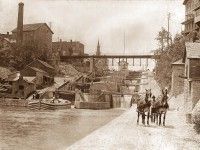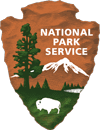
Lockport Caves
The Lockport Cave & Underground Boat Ride along the historic Erie Canal.
On October 26, 1825, the Erie Canal officially opened across New York State. The 365-mile canal passed through Lockport, which would soon become the largest industrial city in Western New York—much larger even than nearby Niagara Falls. Lockport’s growth was primarily spurred by the Lockport Locks, which were blasted out of solid rock during construction of the Erie Canal.
The original five locks lowered canal boats down a 60-foot elevation in the Niagara Escarpment. Since the lower level was artificially made, it risked running dry unless it was fed a constant supply of water. Somehow, the water had to be routed from the upper part of the canal to the lower without disrupting shipping. The future of the entire Erie Canal was at stake.
In 1858, Birdsill Holly, a hydraulic engineer, proposed a solution. His idea was to build an underground tunnel that would draw water from the canal above the locks. This was no small feat. For eight years, Irish laborers used picks, axes, shovels, and dynamite to forge through the dolomite rock. Orphaned boys were used to light gunpowder because they were small and could run fast. Why orphans? Because no one would come looking for them if they died in the explosions. Laborers worked long hours for low wages; sometimes they were paid in whiskey.
The completed tunnel was 20-feet high and one-half mile long. It was the first tunnel to be used for hydraulic power. Its rushing waters provided power to three factories overhead, including the Holly Manufacturing Company. Holly also invented the Holly Fire Protection and Water System, which propelled water from the tunnel into the city’s water mains and fire hydrants. By 1881, Holly’s system serviced more than 100 U.S. cities.
Thomas Edison was so impressed that he came to Lockport to see the spectacular tunnel for himself. Holly would go on to hold over 150 patents, including the fire hydrant, rotary pump, and central steam heat. Holly knew that Niagara Falls was going to be a major tourist attraction, so he also planned to build a 19-story skyscraper. He couldn’t raise the money though. The Skylon Tower was eventually built near the proposed site.
In 1941, the last factory closed along with the tunnel. It reopened as a tourist attraction in 1977 called the Lockport Caves.
Today, tourists can visit Lockport and see some of New York’s most remarkable industrial innovations and take an underground boat ride through the tunnel. There you will see stalactites, geographical cave formations, and historical artifacts left behind by the workers. It is billed as America’s longest underground boat ride.
Hope L. Russell, Ph.D.

